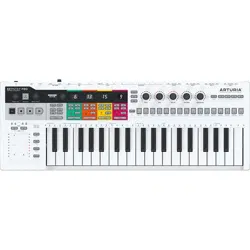Loading ...
Loading ...
Loading ...

5.4.4.2. An Arabic Rhythm
The example below is a very simple traditional Arabic rhythm called Maqsum. It is usually
played on a darbouka: a goblet drum made of clay and a riq; a high-pitched tambourine.
It has a swing feeling to it because the riq leaves the first eighth note in the second beat
empty:
measure 1 measure 2 Instrument
xTxT xxTx riq
Dxxx Dxxx darbuka
To program this rhythm into the KeyStep Pro:
• Select Drum mode on Track 1.
• Select/load a drum kit on your DAW (MIDI) or external synth.
• Play the keys of the lowest octave on the KeyStep Pro to familiarize yourself with
the drum sounds triggered by each key.
• Now, we want to make an 8-step rhythm. To create that, hold down 'Lst Step' and
press the step 8 button.
• Found a bass drum sound? Hold down the key that triggers it and active the
steps on which you want to hear it. To try the above rhythm, select steps 1 and 5.
• Now find a high-pitched drum sound that can play the riq part.
• Hold down the key that triggers it and select steps 2, 4 and 7.
• Press 'Play' to hear your rhythm.
To check whether a particular Drum Track is active in your rhythm, hold down its key. If that
Drum Track has steps that are active (ON), their buttons will light up. Steps that are OFF will
remain unlit.
To deactivate a step, press the appropriate step button.
Things to try:
'Shift' + Rand Order (step 12 button)
'Shift' + Random or Walk (C# or D key under Seq Pattern)
'Shift' + Time Division: 1/4, 1/8, 1/16 or 1/32, or their triplet variants (F, F#, G, G# or A keys of
the middle octave)
106 Arturia - User Manual Keystep Pro - Making Tracks
Loading ...
Loading ...
Loading ...
